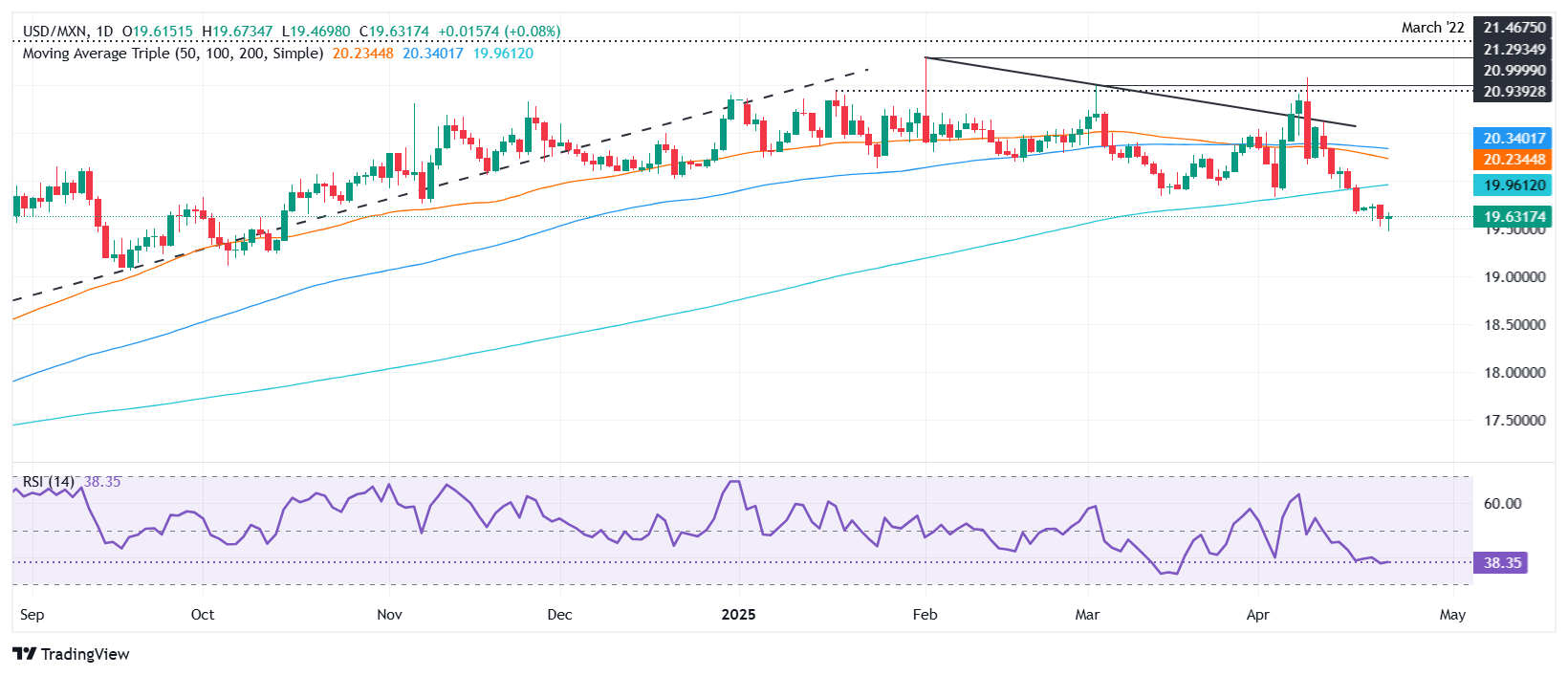- The Mexican weight weakens 0.29% against USD in the middle of the return of the strength of the dollar and the improvement of the feeling of the market.
- Trump says he will not dismiss the president of the FED, relieveing investors’ concerns about the independence of the Central Bank.
- Retail sales in Mexico disappoint; The Citi survey shows a cut growth and stable expectations of cutting of Banxico.
The Mexican peso (MXN) recorded modest losses against the US dollar (USD) on Wednesday in the midst of an improvement in appetite for the risk and recovery of confidence in the dollar, since the US president Donald Trump denied that he would dismiss the president of the Federal Reserve (Fed), Jerome Powell. At the time of writing, the USD/MXN is traded at 19.65, with an increase of 0.29%.
The markets continue to digest the recent news that the US president Donald Trump moderated his attacks on Powell along with a softening of his tariff position towards China, seeking to reach an agreement with Beijing. The Wall Street Journal revealed that Washington is considering reducing tariffs to China, although Trump warned that “it would not be zero.”
Wall Street celebrated the news, although later the US Treasury secretary, Scott Besent, commented that Trump has not offered to reduce tariffs to China unilaterally.
In Mexico, retail sales in February were lower than expected, according to the monthly and annual data of the National Institute of Statistics and Geography (INEGI). Meanwhile, Citi Mexico revealed its latest expectations survey, in which 34 economists updated their forecasts on economic growth, inflation, USD/MXN exchange rate and the monetary policy of the Bank of Mexico (Banxico).
In the economic agenda of Mexico, operators prepare for the publication of mid -month inflation and economic activity data.
What moves the market today: Mexican weight loses impulse while economists expect the cut of Banxico
- The divergence between the Central Bank of Mexico (Banxico) and the Fed favors a greater increase in the USD/MXN. The Banxico Governing Council expressed its decision to continue flexible politics. On the contrary, the Fed is considered cautious, since some officials have shown concerns about a reactivation of inflation driven by tariffs.
- The retail sales of Mexico in February fell from 0.7% to 0.2% monthly, below the forecasts of an increase of 0.3%. In the 12 months until February, sales collapsed from 2.7% to -1.1%, showing the ongoing economic slowdown.
- The CITI Mexico expectations survey shows that economists expect Banxico to cut their rate at 50 basic points at the May meeting. For the whole year, they project that the main reference rate ends about 7.75%.
- As for the USD/MXN exchange rate, private analysts see that the exotic pair ends in 20.93, above 20.90. It is projected that inflation in 2025 ends at 3.78%, with underlying figures at 3.80%, mostly aligned with the previous survey.
- Mexico’s economy is expected to grow 0.2% in 2025, below 0.3% projected in the previous survey.
- Inflation of half of the month in Mexico is expected to increase 3.67% to 3.79% year -on -year and that underlying figures will increase from 3.56% to 3.77% interannual.
Technical Perspective of the USD/MXN: The Mexican weight remains bassist while the USD/MXN remains below the 200 -day SMA
Since it fell below the simple mobile average (SMA) of 19.91, the USD/MXN has acquired a bearish trend, although it has recovered some land after reaching an annual minimum (YTD) of 19.46.
Buyers must recover the 200 -day SMA followed by the 20.00 figure for a bullish resumption. A rupture of this last will expose the confluence of the maximum of April 14 and the 50-day SMA about 20.25-20.29 before trying the 100-day SMA in 20.33.
On the contrary, sellers could test 19.50 followed by the current annual minimum before the 19.00 mark.

Mexican weight FAQS
The Mexican weight (MXN) is the most commercialized currency among its Latin American peers. Its value is widely determined by the performance of the Mexican economy, the country’s central bank policy, the amount of foreign investment in the country and even remittance levels sent by Mexicans living abroad, particularly in the United States. Geopolitical trends can also affect MXN: for example, the Nearshoring process (or the decision of some companies to relocate the manufacturing capacity and supply chains closer to their countries of origin) is also considered a catalyst for the Mexican currency, since the country is considered a key manufacturing center in the American continent. Another catalyst for MXN is oil prices, since Mexico is a key exporter of the raw material.
The main objective of the Central Bank of Mexico, also known as Banxico, is to maintain inflation at low and stable levels (in or close to its 3%target, the midpoint of a tolerance band between 2%and 4%). To do this, the bank establishes an adequate level of interest rates. When inflation is too high, Banxico will try to control it by raising interest rates, which makes the indebtedness of homes and companies more cooling, thus cooling the demand and the economy in general. The highest interest rates are generally positive for Mexican weight (MXN), since they lead to higher yields, which makes the country a more attractive place for investors. On the contrary, lower interest rates tend to weaken the MXN.
The publication of macroeconomic data is key to evaluating the state of the economy and can have an impact on the valuation of the Mexican weight (MXN). A strong Mexican economy, based on high economic growth, low unemployment and high confidence is good for MXN. Not only attracts more foreign investment, but it can encourage the Bank of Mexico (Banxico) to increase interest rates, particularly if this fortress is accompanied by high inflation. However, if the economic data is weak, the MXN is likely to depreciate.
As an emerging market currency, the Mexican weight (MXN) tends to rise for periods of risk, or when investors perceive that the general market risks are low and, therefore, are eager to participate in investments that carry a higher risk. On the contrary, the MXN tends to weaken at times of market turbulence or economic uncertainty, since investors tend to sell higher risk assets and flee to the most stable safe shelters.
Source: Fx Street
I am Joshua Winder, a senior-level journalist and editor at World Stock Market. I specialize in covering news related to the stock market and economic trends. With more than 8 years of experience in this field, I have become an expert in financial reporting.







